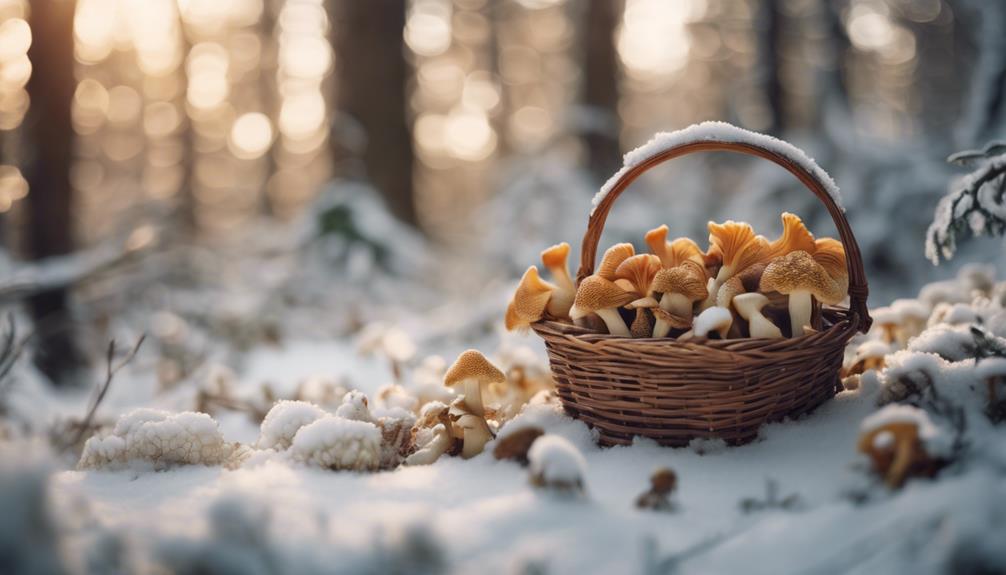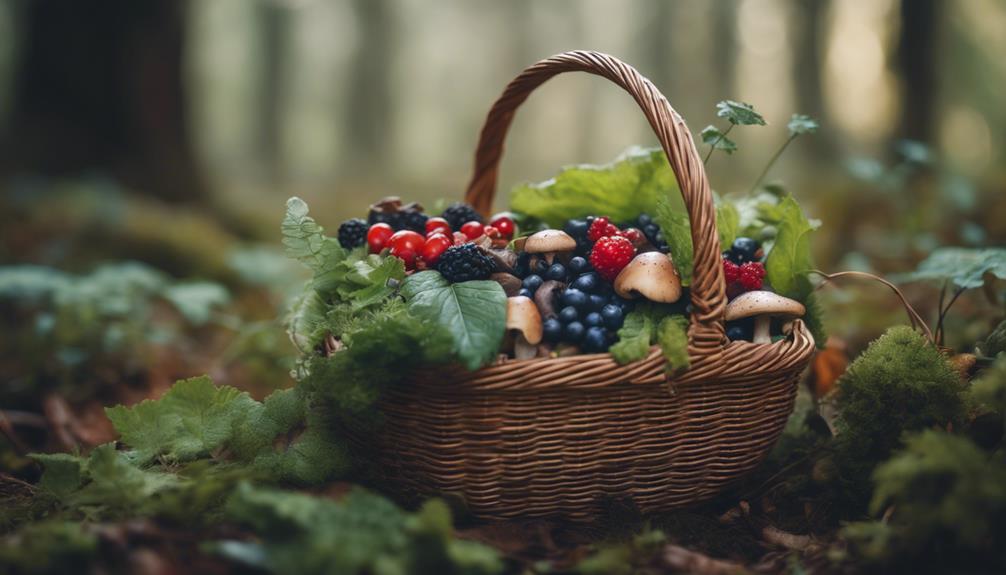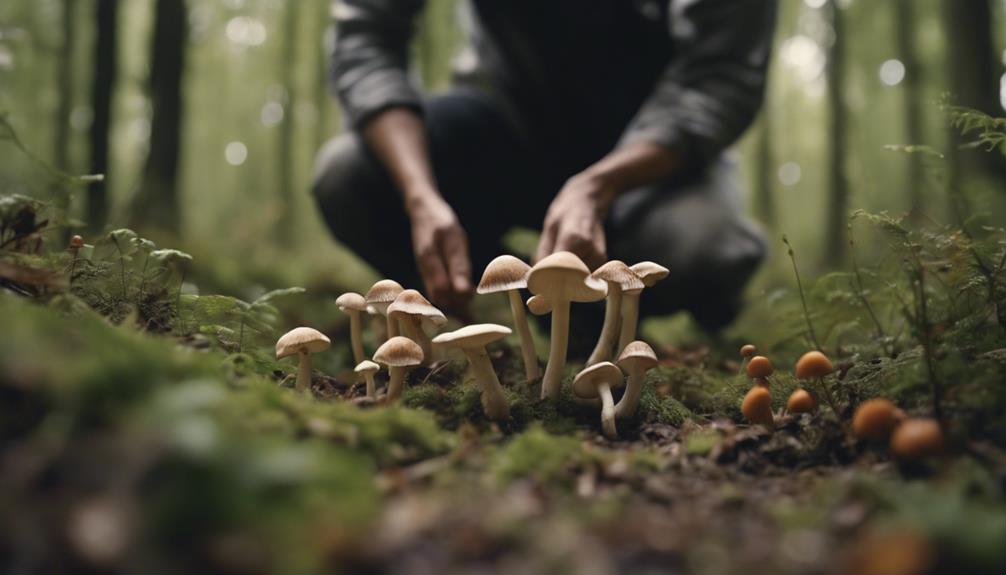You can uncover a surprising abundance of edible treasures in the winter landscape, from nuts and seeds cached by squirrels to resilient berries, medicinal herbs, and fruits that defy the cold. Winter nuts like red oak acorns, hazelnuts, and black walnuts are abundant, while berries like rose hips, hawthorn berries, and wild cranberries provide sustenance. Medicinal herbs like burdock roots, usnea, and Chaga offer health benefits, and fruits like rose hips, persimmons, and frozen wild apples offer flavor and nutrition. As you explore winter foraging, you'll discover a world of cold-season edibles waiting to be uncovered, with many more surprises in store.
Key Takeaways
- Winter foraging offers a variety of nuts, including red oak acorns, hickory nuts, hazelnuts, and black walnuts, which are abundant and nutritious.
- Berries like rose hips, hawthorn berries, and cranberries are resilient and provide sustenance throughout the winter months.
- Medicinal herbs like burdock roots, usnea, and Chaga offer health benefits and can be foraged during the winter season.
- Winter fruits like persimmons, frozen wild apples, and rose hips provide flavor and nutrition when other fruits are scarce.
- Winter greens like chickweed, watercress, and daisy greens are rich in nutrients and can be foraged to boost the immune system.
Winter Nuts and Seeds Galore
As you venture out into the winter landscape, you'll discover an abundance of edible nuts and seeds waiting to be foraged, including red oak acorns, hickory nuts, hazelnuts, and black walnuts. These winter nuts are a treasure trove of sustainable food, and foraging for them can be a fun and rewarding experience.
You might notice that squirrels have beaten you to the punch, caching nuts like acorns and hickory nuts near tree bases for winter food storage. But don't worry, there's plenty to go around! Some tree seeds, like maple seeds, stay on trees until late winter, providing a sustainable food source. By leaving some nuts for animals, you'll help safeguard their survival and maintain ecosystem balance during the winter months.
When foraging, look for acorns and hickory nuts under their parent trees – they're often easily accessible in the colder seasons. So, grab your basket and get foraging! With a little knowledge and effort, you can enjoy the bounty of winter nuts and seeds.
Berries to Brighten Up Winter

You'll find that winter berries are a sweet surprise, waiting to add flavor and nutrition to your winter dishes, with resilient options like rose hips, hawthorn berries, and juniper berries still ripe for the picking.
These cold-season edibles are perfect for foraging during the winter months, providing a burst of flavor and nutrients to your meals.
Beyond these resilient berries, you can also forage for wild cranberries and tart berries, which retain their taste even after freezing. In fact, cranberries are a staple in Polish cuisine, with winter berry picking being a cherished tradition in Northern Poland's wetlands.
When you venture out to forage for winter berries, you'll not only gather delicious ingredients but also foster a deeper connection with nature and appreciation for the seasonal bounty of wild edibles.
Medicinal Herbs for Cold Climes

As you explore the world of winter foraging, you'll discover that certain medicinal herbs thrive in the cold climate, offering natural remedies to combat the season's ailments.
You'll find that these hidden gems, like burdock roots and usnea, possess unique properties that can provide comfort and relief during the harsh winter months.
Winter's Hidden Remedies
During winter's chill, when colds and flu are rampant, foragers turn to the forest for natural remedies, uncovering medicinal herbs that have been hiding in plain sight. You can tap into winter's hidden remedies by exploring the world of medicinal plants that thrive in cold climates.
As part of foraging traditions, many winter edibles offer more than just sustenance; they also provide medicinal properties that can help you combat winter's woes. Burdock Root, for instance, is foraged in the winter for its anti-inflammatory properties. Chaga, a type of fungus that grows on birch trees, is prized for its health benefits and is a popular winter foraged item. Usnea, a type of lichen, is harvested in cold climates for its immune-boosting and antibiotic properties.
Meanwhile, Artist conk and birch polypore are shelf fungi that are foraged in winter for their medicinal uses, including wound healing and immune system support. By embracing these winter edibles, you can create your own natural remedies and tap into the forest's hidden pharmacy.
Cold-Weather Comforters
In the frosty landscape of winter, medicinal herbs like Burdock root, Usnea, Chaga, Birch polypore, and Artist conk stand out as cold-weather comforters, offering a natural respite from the season's chill.
As you venture out to forage in winter, you'll find that these herbs are more than just a warm hug in a mug. They offer tangible health benefits to keep you going through the cold months.
Some of these medicinal herbs can be used in teas, tinctures, or even baked goods. For instance, you can make a delicious Needle Shortbread using conifer needles like Pine or other pine species. You can also use Pine nuts as a nutritious snack or add them to your favorite winter recipes.
- Burdock roots have anti-inflammatory properties to soothe winter's aches and pains.
- Usnea, with its antimicrobial properties, can help combat winter illnesses.
- Chaga, with its immune system support, can help you stay healthy through the cold season.
Foraging for Winter Fruits

As you venture out to forage for winter fruits, you'll discover a bounty of berries and fruits that'll add flavor, color, and nutrition to your winter meals.
From rose hips to persimmons, and from frozen wild apples to wintergreen berries, the options are plentiful and diverse.
Now, let's explore the winter berry bounty and frozen fruit delights that await you.
Winter Berry Bounty
Freezing temperatures don't have to mean a barren landscape; instead, winter offers a surprising bounty of wild berries waiting to be gathered. As you begin your winter foraging journey, you'll discover a variety of cold-weather edibles that can elevate your culinary creations.
Some of the most sought-after winter berries include:
- Rose hips, packed with vitamins and antioxidants, perfect for teas and jams
- Juniper berries, adding a unique flavor to sauces and marinades
- Hawthorn berries, rich in antioxidants and ideal for baking and cooking
Winter foraging is a cherished tradition in many cultures, providing fresh and nutritious ingredients during the colder months. Whether you're a seasoned gatherer or just starting out, a winter berry picking excursion can be a fun and rewarding experience for families and foragers alike.
With a little guidance from a trusted foraging guide, you can uncover the secrets of winter's hidden bounty and bring the flavors of the wild into your kitchen.
Frozen Fruit Delights
You'll uncover a surprising array of winter fruits, from familiar favorites like frozen wild apples and cranberries to less-known treats like persimmons and mountain ash berries, all waiting to be foraged and devoured.
Winter fruits like rose hips, hawthorn berries, and juniper berries provide essential vitamins and antioxidants, making them a nutritious addition to your winter diet.
Frozen wild apples and cranberries offer a burst of flavor and nutrition during the cold season. Persimmons, mountain ash berries, and wild plums are hardy winter fruits that can be foraged in colder climates.
You might also stumble upon viburnum berries, Rumex seeds, and wintergreen berries, which can be used to make invigorating teas.
When foraging for winter fruits, be sure to identify them correctly to guarantee a safe and enjoyable harvest. Take the time to learn about the different species, their habitats, and any lookalikes to avoid.
With practice and patience, you'll be enjoying a diverse range of winter fruits in no time.
Uncovering Hidden Roots and Tubers

Scouting out hidden roots and tubers during winter requires attention to detail, given that many plants have shed their above-ground foliage, leaving only subtle clues to their presence. As you forage for food, you'll need to rely on your knowledge of plant identification to uncover these hidden gems.
Some edible roots to look out for in winter include:
- Burdock roots, which can be roasted or dried for a tasty snack
- Cattail roots, rich in starch and perfect for making flour
- Garlic mustard roots, which can be used in soups or stews for added flavor
When foraging for roots in winter, taking action before the ground freezes solid is crucial. Winter cold can make it challenging to dig up roots, so be sure to gather them before the frost sets in.
As you explore the winter landscape, keep an eye out for plants like Annes lace, highbush cranberries, and sunchokes, which offer hidden treasures in their roots. By doing so, you'll be able to enjoy a bounty of nutritious and flavorful roots all winter long.
Edible Bark and Sap Delights

As winter's chill sets in, the dormant trees offer a secret bounty: aromatic barks ripe for harvesting, their flavors and nutrients waiting to be revealed. You can uncover the culinary potential of winter's edible bark and sap delights.
Sassafras, spicebush, shagbark hickory, and yellow birch bark are worth harvesting for their unique flavors and nutrients. Shagbark hickory bark, for instance, can be used to make a delicious syrup, adding a distinct flavor to dishes. Yellow birch bark, on the other hand, can be fermented into an invigorating cream soda-like drink.
Winter is an ideal time for bark harvesting, as the dormant trees make it easier to extract flavors and nutrients. This sustainable way of foraging offers a chance to connect with nature and explore new culinary possibilities.
Coniferous Delights for Winter

Coniferous trees, like white pine and cedar, provide a winter cornucopia of edible treasures, from needles and cones to bark and sap, all waiting to be accessed for teas, soups, and other culinary delights. As you venture into the winter landscape, you'll find that conifer trees offer a wealth of cold-weather edibles, perfect for warming up on a chilly day.
Some of the coniferous delights you can forage in the winter include:
- Pine needle tea: rich in vitamins and antioxidants, this nutrient-rich tea is a winter staple
- Edible nuts: conifer trees provide a bounty of nuts like pine nuts, acorns, and black walnuts, packed with nourishment
- Foraged berries: juniper berries, rose hips, and hawthorn berries persist through winter, offering essential nutrients and flavor to your winter dishes
As you explore the world of coniferous delights, remember to always identify the trees correctly and harvest sustainably to safeguard the longevity of these winter wonders. With a little knowledge and practice, you can access the secrets of coniferous delights and enjoy a winter filled with flavorful and nutritious treats.
Winter Greens for the Table

While coniferous trees offer a wealth of winter edibles, you'll also find a variety of winter greens thriving beneath the snow, providing a fresh and flavorful addition to your cold-weather cuisine. As you forage for these winter greens, you'll discover an array of essential nutrients and flavors to enhance your seasonal meals.
Chickweed, watercress, and daisy greens are just a few examples of the winter greens that can be found during the cold season. These greens are rich in vitamins, minerals, and antioxidants, making them a healthy addition to your winter meals. By incorporating these winter greens into your diet, you'll not only add flavor and variety but also give your immune system a boost.
Foraging for winter greens can be a fun and rewarding activity, especially in regions where they're abundant. So, take the time to forage for these winter greens and reap the benefits of their nutritional value. With a little effort, you can enjoy a fresh and flavorful winter meal that's packed with essential nutrients.
Uncommon Winter Edibles to Try

You'll stumble upon a trove of unexpected winter treasures, like frozen cranberries and cattail shoots, hidden beneath the snow or submerged in icy streams. As you venture into the winter foraging scene, you'll discover a world of uncommon edibles waiting to be tried.
Some of these hidden gems include:
- Oyster mushrooms growing on tree trunks, their delicate flavor a perfect addition to winter soups
- Wild garlic, with its pungent aroma and flavor, adding depth to winter dishes
- Dock plants, whose leaves and dock seeds harvested in winter can be used in salads or as a cooking green
Winter months offer a unique opportunity to forage for these and other underappreciated delicacies.
Wild grapes, Turkey tail, and Mustard family plants can be found, along with Pine trees whose needles can be used to make a revitalizing tea.
As you explore the world of winter foraging, remember to always identify your finds accurately and harvest sustainably to guarantee a bounty for seasons to come.
Frequently Asked Questions
What Is Edible for Winter Foraging?
You'll find that frozen cranberries, wild garlic, and garlic mustard are all edible winter finds. Berries like rose hips and juniper berries are also abundant, along with roots like burdock and parsnip, and mushrooms like oysters and chaga. Foraging in New Jersey during the winter months may also yield treasures like pine needles, which can be brewed into a vitamin C-rich tea. Additionally, hardwood trees such as maple provide bark that can be carefully harvested and dried for medicinal purposes. Always make sure to properly identify wild plants and understand local foraging regulations before embarking on your winter adventure. Other notable winter foraging finds in New Jersey include hickory nuts and acorns, which can be processed to create nutrient-dense flours or roasted for snacks. Learning **what to forage in New Jersey** during the colder months also opens up opportunities to gather young dandelion greens, which offer a bitter yet nutritious addition to winter salads. Remember to forage responsibly, leaving enough for wildlife and ensuring sustainability for future seasons.
What Wild Berries Are Edible in Winter?
You'll find that rose hips, hawthorn berries, juniper berries, cranberries, and wild plums remain edible in winter, providing a flavorful and nutritious addition to your winter dishes and teas.
What Foods Are Winter Foraged?
You're likely to find that 70% of winter foraged foods are roots, nuts, and mushrooms! As you venture out, you'll discover delicious treasures like oyster mushrooms, hickory nuts, and burdock roots waiting to be unearthed.
What Herbs Can You Forage in the Winter?
You can forage for nettle, wild garlic, yarrow, chamomile, St. John's wort, and elderflower in winter for teas and medicinal uses, just like Polish folk medicine and culinary traditions have done for centuries.
Conclusion
As you bundle up to face the winter chill, remember that the season's chill doesn't mean foraging has to freeze. Like a treasure chest overflowing with hidden gems, winter's landscape is rich in edible delights waiting to be uncovered.
From nuts and seeds to berries, medicinal herbs, and roots, the possibilities are endless. So, venture forth and unearth the winter wonders that lie beneath the frost, and savor the flavors that only the cold season can bring.










